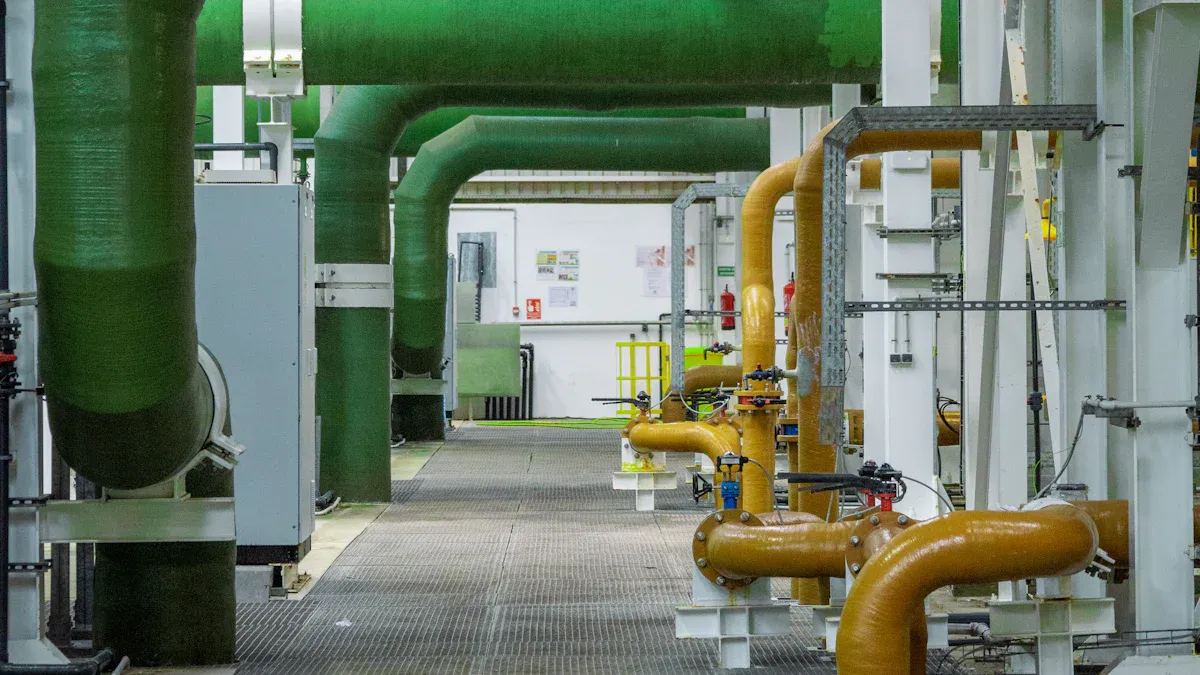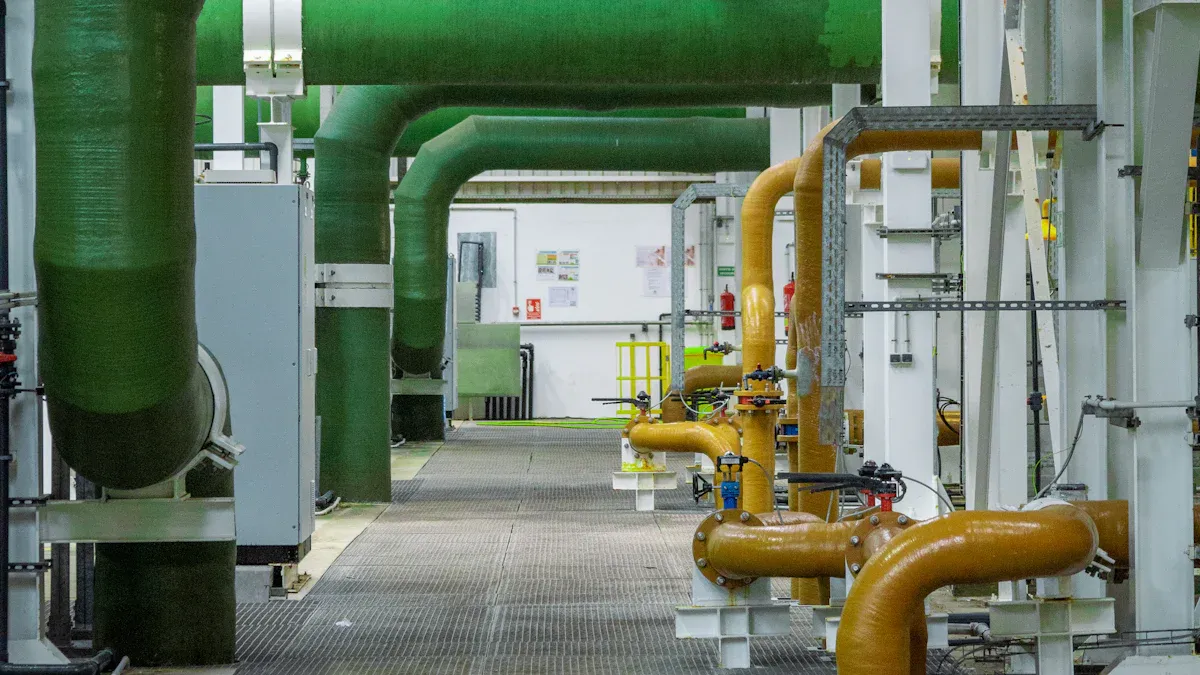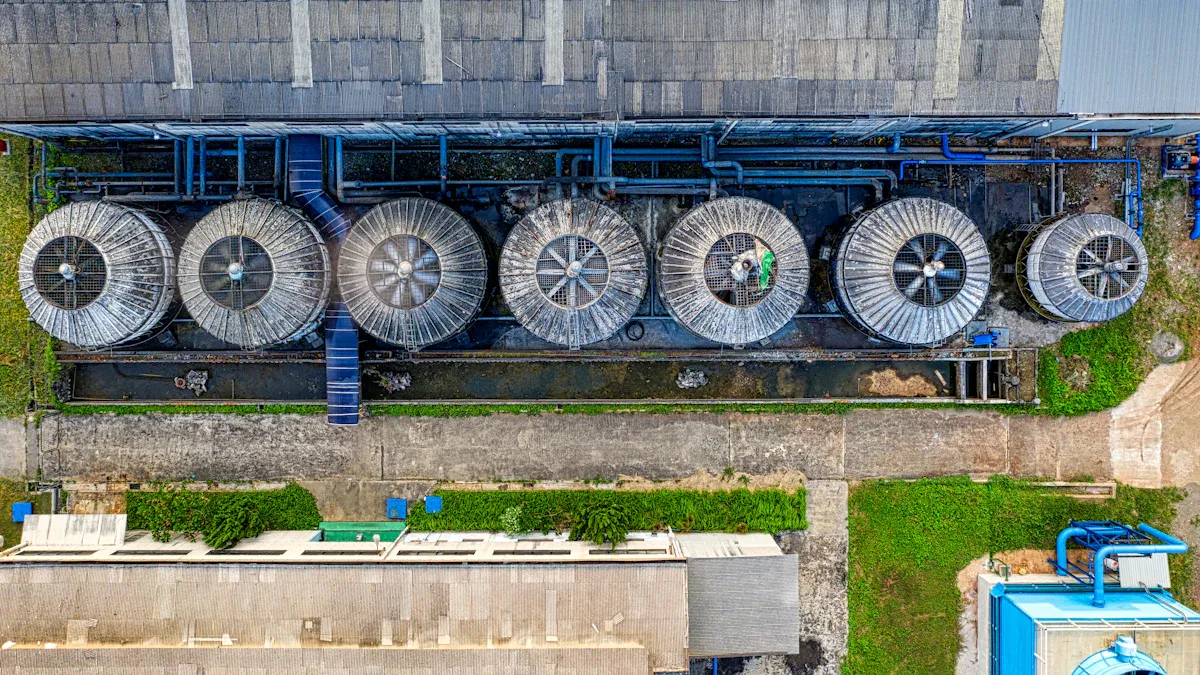Low temperature chiller basics and how it cools

A low temperature chiller cools fluids much colder than the air. You use a low temperature chiller when you need very cold liquids. It is used in science labs, food making, or big machines. This chiller takes heat out of fluids fast. It keeps them at a steady, low temperature.
Key Takeaways
Low temperature chillers make fluids much colder than normal chillers. They can cool fluids down to -120°F (-85°C). These chillers use a special refrigeration cycle. They have parts like compressors, condensers, and evaporators. These parts help remove heat and keep fluids cold all the time. You can pick air-cooled or water-cooled chillers. Your choice depends on your space and how much cooling you need. Low temperature chillers have strong safety features. They save energy with closed-loop systems. They work well in labs, factories, and medical places. Doing regular maintenance is important. Using the right chiller for your job keeps your equipment safe. It also helps everything work well.
Low temperature chiller overview
What is a low temperature chiller
If you need to make liquids much colder than room temperature, you use a low temperature chiller. This machine can cool things more than normal coolers can. You will see these chillers in science labs, food factories, and chemical plants. They take heat out of liquids fast and keep them cold for as long as needed.
A low temperature chiller moves heat away from the liquid. It has special parts that help with this job. You can use it to cool chilled water, alcohol, or other fluids. The machine keeps the temperature steady. This helps your work stay safe and reliable.
Tip: A low temperature chiller is a good way to stop your equipment from getting too hot.
Temperature ranges
You might ask how cold a low temperature chiller can get. Most chillers cool liquids from -10°F to -120°F (-23°C to -85°C). Some special models can go even lower. You can use very cold water for ice baths, testing electronics, or making medicine.
Here are some ways people use low temperature chillers:
Cooling science tools
Making ice baths for tests
Keeping chemicals safe during work
Chilling water for food making
Very cold water from a low temperature chiller helps many jobs stay safe and work well. If you need more cooling than a regular chiller, a low temperature chiller gives you that extra power.
Chiller components

Main parts
Every low temperature chiller has important parts inside. Each part does a different job. The compressor is like the heart. It pushes the refrigerant through pipes. The refrigerant takes heat away from your fluid. Scroll chillers use a scroll compressor. These chillers are quiet and last long.
The condenser cools the hot refrigerant. It turns the refrigerant from gas to liquid. The evaporator uses cold refrigerant to take heat from your fluid. Here, the refrigerant becomes a gas again. The expansion valve controls how much refrigerant goes in. This helps keep the temperature steady.
Most scroll chillers have controls you can use. You can set the temperature and check the system. Many have alarms and safety features. Some have defrost systems to stop ice from forming. Some chillers have ports for connecting to other machines.
Note: The refrigerant is very important. It moves heat out of your fluid and makes cooling work. Scroll chillers use special refrigerant types for low temperatures.
Air-cooled vs. water-cooled
You can pick air-cooled or water-cooled chillers. Air-cooled low temperature chillers use fans to blow air over the condenser. This cools the refrigerant. These chillers are easy to set up and use less water. Water-cooled chillers use water to cool the refrigerant. They work better in hot places or when you need more cooling.
Scroll chillers come as air-cooled or water-cooled. Air-cooled scroll chillers work well outside or where air moves well. Water-cooled scroll chillers are good for big buildings or factories. Both types use refrigerant to move heat. Pick the one that fits your space and cooling needs.
How a low temperature chiller works

Cooling process
You might ask how these chillers make fluids so cold. They use something called the refrigeration cycle. This cycle takes heat out of your fluid and moves it away. Many coolers, like your fridge at home, use this idea too.
Here is how it works, step by step:
The compressor pushes the refrigerant through the pipes. The refrigerant starts as a gas with low pressure.
The compressor squeezes the gas. This makes it hot and raises the pressure.
The hot refrigerant goes to the condenser. The condenser cools it down and turns it into a liquid.
The liquid refrigerant moves to the expansion valve. The valve lets it expand and get cold fast.
The cold refrigerant goes into the evaporator. Here, it takes heat from your fluid. This makes your fluid cold.
The refrigerant turns back into a gas. It goes to the compressor again. The cycle keeps going.
Tip: The closed-loop system keeps the refrigerant moving in a circle. This saves energy and keeps cooling steady.
Scroll chillers work well for many cooling jobs. They last a long time. The closed-loop system means you do not lose refrigerant during normal use.
Role of each component
Each part in scroll chillers has its own job. Knowing what each part does helps you understand the system.
Compressor: This part acts like a pump. It moves the refrigerant and makes it high pressure. Scroll chillers use a scroll-type compressor. These are quiet and strong.
Condenser: The condenser cools the hot refrigerant. It changes it from a gas to a liquid. Air-cooled and water-cooled chillers cool the condenser in different ways.
Expansion valve: This valve controls how much refrigerant goes into the evaporator. It helps keep the temperature right.
Evaporator: The evaporator is where the cold happens. The cold refrigerant takes heat from your fluid. Your fluid gets cold. The refrigerant turns into a gas again.
Refrigerant: This is the fluid that moves heat out of your fluid. It carries the heat away. Scroll chillers use special refrigerants for very low temperatures.
Controls and sensors: These parts let you set the temperature and watch the system. Many chillers have alarms to warn you if something is wrong.
Scroll chillers use all these parts together in a smart way. The closed-loop system keeps the refrigerant inside the pipes. The system keeps cooling your fluid over and over. This gives you steady and reliable cooling.
Note: Scroll chillers are special because they use a scroll compressor and special refrigerant. This lets them get much colder than regular chillers.
If you want to keep your work safe and your equipment cool, scroll chillers give you the power and control you need. You can trust these chillers for hard jobs in labs, factories, and more.
Differences from standard chillers
Temperature capability
You might ask how low temperature chillers are different from standard chillers. The main difference is how cold they can make fluids. Standard chillers cool fluids to about 40°F (4°C). This is good for things like air conditioning or cooling small machines.
Low temperature chillers can get much colder than that. You can set them as low as -120°F (-85°C). This extra cold helps with special jobs. For example, you might need to freeze chemicals, test electronics in the cold, or keep medicine safe.
Here is a simple chart to compare:
Chiller Type | Typical Lowest Temperature |
|---|---|
Standard Chiller | 40°F (4°C) |
Low Temperature Chiller | -120°F (-85°C) or lower |
Note: If you need fluids colder than ice, use a low temperature chiller.
Design and application
Low temperature chillers are built to handle very cold jobs. They have thick insulation on pipes and tanks. This keeps the cold inside and saves energy. The compressor and refrigerant inside are made for very low temperatures. Standard chillers do not need these special parts.
You will find more safety features in low temperature chillers. Many have alarms, sensors, and systems that shut off by themselves. These features help protect your tools and your work. Some models can connect to computers or building systems for easy control.
Standard chillers are used for normal cooling, like in offices or small factories. Low temperature chillers are best for science labs, chemical plants, or places that need very cold fluids.
Standard chillers: Good for easy cooling jobs.
Low temperature chillers: Best for special jobs that need extra cold.
Tip: Always pick the right chiller for your job. Using the wrong one can waste energy or break your equipment.
Uses and benefits
Common industries
Low temperature chillers are used in many places. They help keep things cold when it is needed. In labs, chillers keep samples safe and cool. Food factories use chillers to cool food fast. This stops bacteria from growing. Chemical plants use chillers to control reactions. This keeps workers safe. Electronics companies use chillers to test devices in the cold. Hospitals and clinics use chillers to store medicine and vaccines at the right temperature.
Here are some places that use low temperature chillers:
Scientific research labs
Food and beverage production
Chemical processing plants
Electronics manufacturing
Medical and pharmaceutical facilities
If your job needs cold temperatures all the time, a low temperature chiller helps you work safely and well.
Key advantages
Low temperature chillers have many good points. They let you control the temperature very closely. This keeps your process steady. These chillers are great for cooling fluids that need to be extra cold. You can count on them to stop your machines from getting too hot. They save energy because they use closed-loop systems. This means you do not waste water or refrigerant.
You can use chilled water from these chillers for many things. You can cool machines, store products, or run tests. Many chillers have alarms and safety controls. These features protect your work and warn you if there is a problem. Some chillers can connect to computers for easy checking.
Accurate temperature control
Energy savings with closed-loop design
Safety features and alarms
Flexible use in many industries
A low temperature chiller helps you feel calm. You know your work will stay cool and safe every time.
Now you know a low temperature chiller makes fluids much colder than room temperature. This machine uses a special cycle to take away heat. It helps keep your work safe. You get steady and reliable cooling for many different jobs. Always pick the chiller that fits your needs best. If you want more information, look at guides from the makers or talk to an expert for help.
Tip: Reading technical manuals can help you learn about advanced features and how to take care of the chiller.
FAQ
How often should you maintain a low temperature chiller?
You should check your chiller every month. Clean the filters and inspect for leaks. Schedule a full service once a year. Regular care helps your chiller last longer and work better.
Can you use tap water in a low temperature chiller?
You should not use tap water. Tap water can cause scale and rust inside the chiller. Use distilled or deionized water for best results. This keeps your system clean and running smoothly.
What happens if your chiller runs out of refrigerant?
The chiller will stop cooling if it runs out of refrigerant. You may see warning lights or hear alarms. Call a technician right away. Running the chiller without refrigerant can damage the compressor.
How do you know if your chiller is too small for your job?
If your chiller cannot keep fluids cold, it may be too small. You might notice the temperature rising or the chiller running all the time. Choose a chiller with enough power for your needs.
Are low temperature chillers safe to use indoors?
Yes, you can use most low temperature chillers indoors. Make sure the room has good airflow. Keep the area around the chiller clear. Always follow the safety instructions in the manual.

